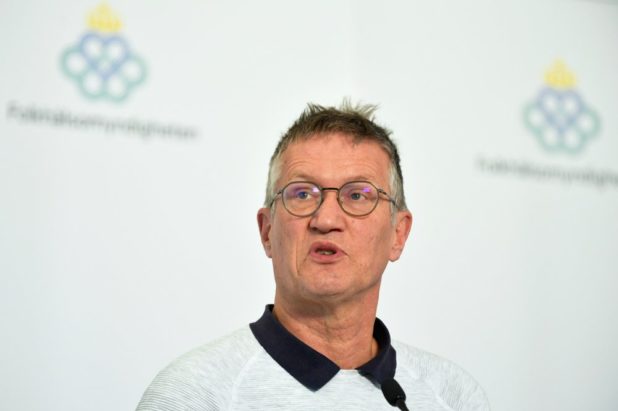
Every country under lockdown benefits from criticizing Sweden’s approach to fighting the alleged “coronavirus” pandemic because if it ends up working, Sweden would still have a functioning economy and Swedes wouldn’t have lost their minds in isolation.
Sweden’s chief epidemiologist Anders Tegnell explains why even if Sweden has more deaths of coronavirus now, it will end up having the last laugh later.
AP:
Crowds swarm Stockholm’s waterfront, with some people sipping cocktails in the sun. In much of the world, this sort of gathering would be frowned upon or even banned.
Not in Sweden.
It doesn’t worry Anders Tegnell, the country’s chief epidemiologist and top strategist in the fight against the coronavirus pandemic.
The 63-year-old has become a household name in Sweden, appearing across the media and holding daily briefings outlining the progression of the outbreak with a precise, quiet demeanor.
As countries across Europe have restricted the movement of their citizens, Sweden stands out for what Tegnell calls a “low-scale” approach that “is much more sustainable” over a longer period.

So far, Sweden has banned gatherings larger than 50 people, closed high schools and universities, and urged those over 70 or otherwise at greater risk from the virus to self-isolate.
The softer approach means that schools for younger children, restaurants and most businesses are still open, creating the impression that Swedes are living their lives as usual.
…
And while most businesses in Sweden are still operating, the economic cost of the pandemic is already being felt. Last week, 25,350 Swedes registered as unemployed, according to the Stockholm Chamber of Commerce — a larger increase than during the 2008 financial crisis.
In contrast, just across a narrow strip of sea, neighboring Denmark is already talking about reopening society. They imposed a much stricter lockdown four weeks ago, closing borders, schools and businesses. This week, the prime minister said by acting early, Denmark averted the tragedy that struck hard-hit nations like Italy and Spain, which together have seen at least 37,000 virus-related deaths, and will be ready after Easter for a slow return to normal life that starts with reopening preschools and primary schools.
Notice the wording there, as if lockdowns were something a country has to go through once to get it over with.
That’s obviously not the case. “Experts” have been saying for weeks now that people will either have to endure multiple lockdowns or a huge one until a vaccine for coronavirus is developed, which is objectively an insane proposition considering that coronavirus is literally just the flu, that the virus could just keep mutating, and that new viruses could appear altogether.

If “going into full lockdown” is going to be the strategy every time the virus mutates or a new virus appears, then people will live most of their lives in isolation.
On the other hand, doing what Sweden is doing is a much saner — or perhaps the most sane — approach to dealing with viruses that are only really a threat for old and sick people.
For weeks, the numbers of COVID-19 cases and fatalities were proportionally similar between Sweden and Denmark, but while the economic results of the strict isolation are being felt in Denmark, Sweden’s mortality rate has reached more than 88 dead per million, compared with around 47 dead per million in Denmark.
Sweden, with a population of 10 million, has registered 899 deaths, while Denmark, with 5.8 million people, has 273 deaths. Worldwide, the virus has infected a reported 1.8 million people and killed 114,000, according to a tally by Johns Hopkins University. Still, due to limited testing, different ways of counting the dead and deliberate under-counting by some governments, experts believe those numbers vastly understate the pandemic’s true toll.
That’s not even much of a difference right now, but the comparison is unfair because any country going through a lockdown will have to eventually open up and that’s when they’ll be where Sweden is right now in terms of movement of people.

For all we know, once lockdowns end, the “coronavirus” death rate could end up increasing up to a similar level than Sweden’s.
If that happens, the obvious question to ask would be “why even go through the lockdown in the first place?”
After a sharp spike in deaths in Sweden, Prime Minister Stefan Lofven proposed an emergency law allowing the quick closure of public venues and transportation if needed. Lofven also warned citizens to prepare for possibly up to thousands of deaths.
Nevertheless, Tegnell, the chief epidemiologist, insists that Sweden’s approach still seems to make sense, though he also acknowledges that the world is in uncharted territory with the virus.
He argues that while Sweden might have more infections in the short term, it will not face the risk of a huge infection spike that Denmark might face once its lockdown is lifted.
“I think both Norway and Denmark are now very concerned about how you stop this complete lockdown in a way so you don’t cause this wave to come immediately when you start loosening up,” he said.
He said authorities know that the physical distancing Swedes are engaging in works, because officials have recorded a sudden end to the flu season and to a winter vomiting illness.
That’s true, but we should also consider that even if the number of deaths attributed to coronavirus ends up being higher for Sweden, the total number of deaths as a result of the handling of the “pandemic” will likely be stunningly smaller than what countries that destroyed their economies will have.
Once enough jobs disappear, desperation kicks in, and riots start, deaths are likely to increase.
Even without thinking that far into the future, the United Kingdom expects about 150,000 people to die as a result of the lockdown itself, not the disease.
Sweden is not going to have that problem.

